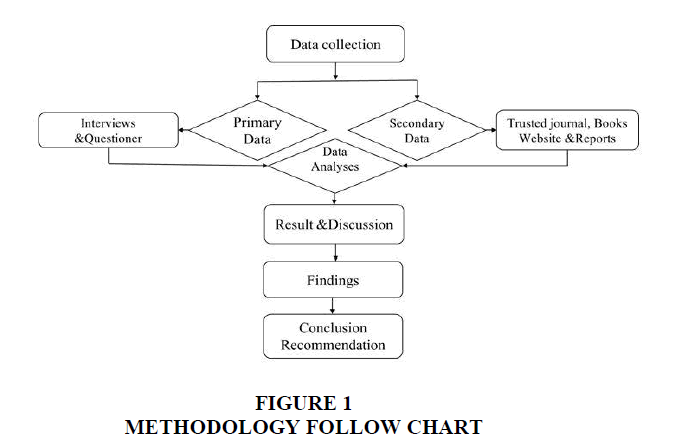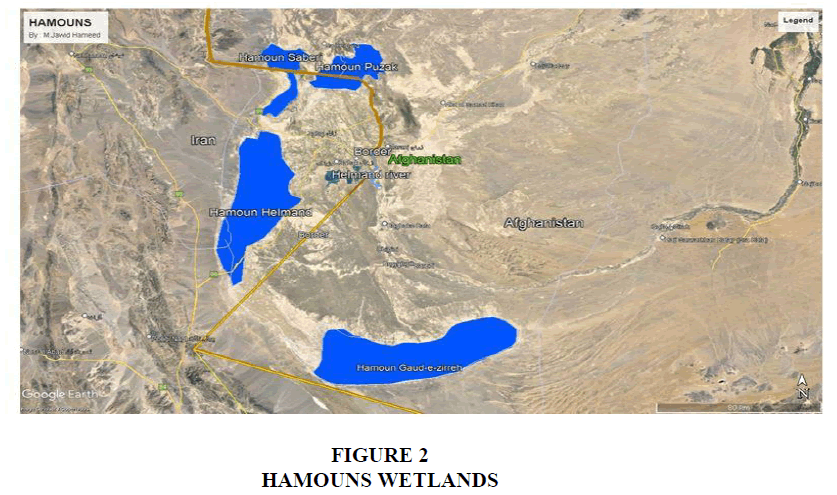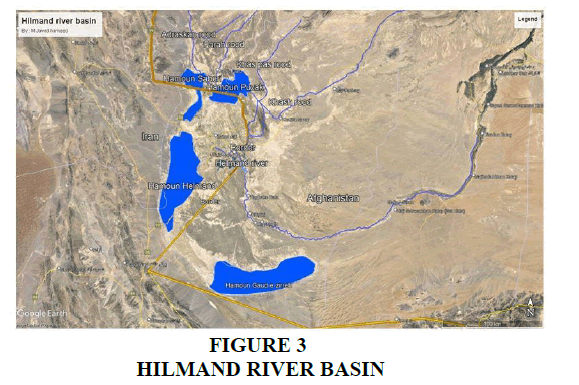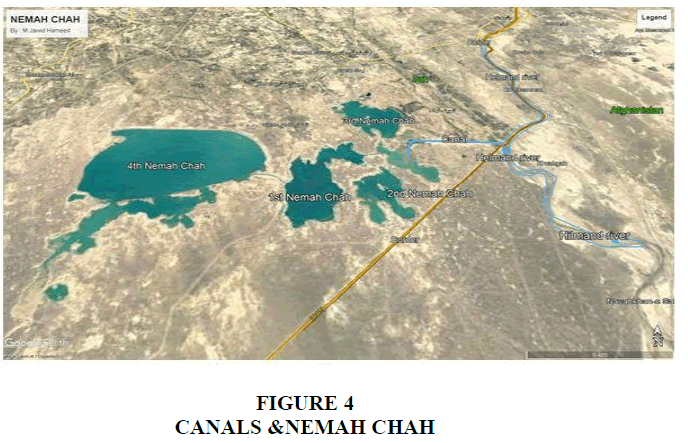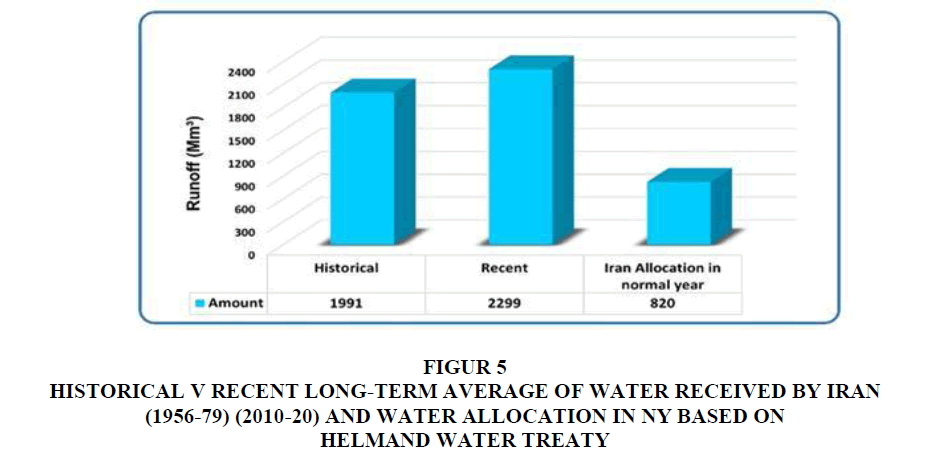Review Article: 2022 Vol: 26 Issue: 4
Does the Blaming Game of States Escalate Tensions or Bring Alliance?
Mohammad Ibrahim Koshaa, Kandahar University
Muhammad Jawid Hameedb, Kandahar University
Ahmad Ahmadzai, Kandahar University
Citation Information: Koshaa, M.I., Hameedb,M.J., & Ahmadzai, A. (2022). Does the blaming game of states escalate tensions or bring alliance?. Journal of Organizational Culture Communication and Conflict 26(4), 1-11.
Abstract
Hamoun wetlands are the historical part of Afghanistan and Iran and has thousands of years of history. These lakes have a significant role in the development of agriculture, ranch, fish farming, environment and anti-air pollution. This area was one of the best settlements for animals and immigrant birds, which is currently destroyed due to lack of attention and mismanagement of riparian states. Literature indicates that Iran blames the Afghan side for lack of water allocation to Hamouns. However, Afghanistan refuses this allegation and claims that Iran is receiving much more water than the amount allocated in the Helmand water treaty to meet the demands of the environment, domestic and agriculture. Yet Iran is diverting the water to the artificial wells. Additionally, hundreds of water pumps are installed in the Iran side of transboundary waters and are utilized for irrigation and domestic purposes. This paper focus on the current legal situation of Hamouns wetland and analyses the international water law, equitable reasonable use of transboundary waters and the Helmand water treaty between Afghanistan and Iran. To come up with the peaceful settlement of the dispute, conflict over water, and assist in recognizing the blame side of states. Finally, to encourage the riparian state to maintain the world culture inherent from conflict to cooperation and resolving socio-economic problems and challenges.
Keywords
Hamoun Wetlands, Treaty, Blaming Game, Ecosystem, Dispute, Climate Change.
Introduction
Hamoun wetlands are Located on Afghanistan and Iran border and originates from the Helmand River, and the wetlands are the primary source of sustenance and shelter for the people of South Asia. (Werier, 2002) For the sake of climate change, mismanagement, and shortage of water, the Hamoun is altered to wasteland. The loss of available water in wetlands was followed by large-scale land abandonment in rural areas, migration to the cities, and increasing unemployment and economic hardship (Maleki et al., 2019).
The Hamoun is the best resource for freshwater, as well as shelter, food point of many migrating birds in the region, and the livelihood of the citizens. It was based on hunting, fishing, and farming and irrigated agriculture. The Hamoun wetlands are likewise the economic base in absence of any industry independent of water and the natural ecosystem in the region. Due to , the worst ongoing drought in the region, the local fish and bird populations all disappeared, and the negative impacts of climate change on ecosystems have increased (Maleki et al., 2019).
Furthermore, Hamoun played a vital role in previous years in economic development, social and environment. These lakes are one of the job creations for residents of Hamouns like ranches and fish farming. Overall, 12 thousand kinds of fish were obtained in the region (Mahmoodi, 2017). Furthermore, the residence of Hamouns engaged agricultural activities around the cultivated lands. Also, the non-cultivated lands side was used for silage again these eras were famous for tourist and economic purposes for the residence.
One of the most significant matters at stake is the transboundary water management of the Helmand River. A water-sharing agreement between Afghanistan and Iran was agreed upon in 1973. The political boundary between Iran and Afghanistan divided the Hamoun system, complicating management possibilities more in the area. Ninety percent of the watershed is located in Afghanistan, and practically all the wetlands’ water sources originate there (Post-Conflict, 2006)
For many years, Iran and Afghanistan have had disputes, but this conflict isn’t major territorial disputes, unlike Afghanistan and Pakistan or Pakistan and India. Though, according to the Atlantic Council (an American think tank in the field of international affairs), this disagreement over-allocation of water from the 1870s when Afghanistan was under British control, the Helmand River is threatening their relationship as each side suffers from droughts, climate change, and the lack of proper water management (Aman, 2016; Atlantic Council, 2016)
For the sake of these mentioned reasons, the Iran side blame and argue that after the construction of the Kajaki Dam in 1960, Afghanistan blocked the water stream to the Hamouns and due to lack of water rights of Hamouns wetlands from Afghanistan side caused to shrivel of Hamouns wetlands (Aman, 2018; Ands, 2013).
In 1939, the Iranian government and Afghanistan government from the Iranian side Reza Shah Pahlavi and Afghan side Mohammad Zahir Shah’s signed a treaty on sharing the river’s waters, but the Afghans failed to ratify it.
Also, after four years of conflict, finally, in 1973, both sides agreed on accord the flow of water into Iran side twenty-six cubic meters per second. The treaty was signed by Iranian Prime Minister Amir Abbas Hoveida and Afghan Prime Minister Mohammad Musa Shafiq, with an option for Iran to purchase an additional four cubic meters per second in normal water years. (Ashrafizadeh, 2022).
The Iranian government agreed to allow the Chabahar and Abbas harbors to be available to Afghanistan. Without preconditions, this agreement was neither ratified nor fully implemented due to the political changes in both countries, such as a coup 1973 in Afghanistan and revolution1979 in Iran. (AMAN, Atlantic Council, 2016).
The overall objective of this paper is existing lawful circumstances of Hamouns wetland and analyses the international water law, equitable, reasonable use of transboundary waters and the Helmand water treaty between Afghanistan and Iran. To come up with the peaceful settlement of the dispute, conflict over water, and assist to recognize the blame side of states, Finally, to encourage the riparian state to maintain the world culture inherent from conflict into cooperation and resolving socio-economic problems and challenges.
The specific objectives of the paper are the Hamoun wetland's current legal situation, the existing challenges, analysis of conflict over water between Iran and Afghanistan according to equitable and reasonable use of water, and Helmand water treaty.
The paper is constructed in 5 parts: 1- introduction 2- literature review 3- methodology 4- result and discussion 5- conclusion and recommendation.
Literature Review
More than 40 years ago, The Ramsar Convention was established to protect wetlands everywhere globally. In the present day, there are more than 2,000 wetlands, covering 476,000 acres, designated as Wetlands of International Importance. The destruction of wetlands is a major concern because they are approximately productive habitats that support significant concentrations of animals, birds, and fishes.
Without wetlands, cities have to spend more money to treat water for their citizens, floods are more devastating to nearby communities, storm surges from hurricanes can penetrate farther inland, animals are displaced or die out, and food supplies are disrupted, along with livelihoods, in addition, the ecosystems would have destroyed. It is speculated that half of the world’s wetlands have disappeared since1900, despite their value to the human population. In some places, the rate of wetlands destruction occurs at incredible speeds, like Hamouns wetlands in Iran and Afghanistan (World Wildlife Fund, 2022).
Poor governance of international trans-boundary water resources often results in water conflicts of varying intensities. Transboundary water problems are well-argued in numerous research outcomes like less water will flow across the borders of Afghanistan, such as through rivers in the Helmand River basin to Iran. This can result in increased tensions. Also, attempts at the home of conserving water or using more water can further increase the tension between neighboring states (CPAU, 2011; Sistani, 2017; Tajrishi, 2018).
In addition, to save and restore the Hamoun wetlands, various studies and activities have been carried out by different organizations. For instance, holding trilateral meetings between Iran and Afghanistan by UNEP in Tehran and Geneva, negotiations between Iran and Afghanistan in high-level authorities, international implementation (preparing and executing cooperation programs of Iran, Afghanistan and international organizations such as UNEP and financial agencies like GEF for assigning environmental water, proper rehabilitation of Hamoun wetland, the proposal of bilateral cooperation in studying and execution of common agricultural, economic and social projects in Nimroz province (Afghanistan) and Sistani basin (Iran) and stabilization plans for sand flowing), “Sustainable ecosystem management of Sistan” was approved by GEF/UNDP, it has not yet been implemented, the establishment of Hamoun Restoration Committee in Sistan and Baluchistan Province. (businessdocbox.com)
Methodology
This study is based on a review of Helmand River basin water, Hamoun wetland issues between Afghanistan and Iran. To analyze and explore the conflict situation, the paper type is analytical and informative. The paper's methodology included a desk review of existing research on transboundary waters in Afghanistan, such as books, Relevant study reports, websites, publications, and informative material collected from various governmental and non-governmental organizations. And primary data in the form of semi-structured interviews and questioners with several Key Informants in the Afghan Government, Afghanistan academic institutions, Afghan researcher, identified based on their experience and affiliation with transboundary water resources development and management. The methodology follows the chart shown in (Figure 1).
Case Study of Hamoun Wetlands
The Ramsar Convention on Wetlands of International Importance defines wetlands as areas of marsh, fen, peatland or water, whether natural or artificial, permanent or temporary, with water that is static or flowing, fresh, brackish or salt, including areas of marine water the depth of which at low tide does not exceed six meters (Suman, 2019)
The Hamouns are transboundary wetlands on the Iran-Afghanistan boundary Consists of four wetlands, as shown in Figure 2 (Fahim, 2012).
1. Hamoun-e Helmand, which is entirely in Iran
2. Hamoun-e Sabari on the border
3. Hamoun-e Puzak is almost inside Afghanistan.
4. Gaud-e-Zirreh lake entirely inside Afghanistan
The total area of these Hamouns is 7421,2 km2 the capacity is around 36.7972 billion m3 Gaud-e-Zirreh is one of the most significant lakes of these region depths is around 10meter, and the total area is 24175 km2 water capacity is almost 24 billion m3. The three lakes are linked and fed by water from the Helmand River, which starts in the Hindu Kush Mountains in Afghanistan. The Hamouns volume calculated by UNEP is shown in the (Table 1). (Mahmoodi, 2017; Mahboob, 2018).
| Table 1 The Hamouns Volume Calculated By Unep |
|||
|---|---|---|---|
| Uite | Average depth(m) | Area(Km2) | Volume million (m3) |
| Hamoun-e elmand | 2 | 2388.8 | 4777.5 |
| Hamoun-e Sabari | 3 | 1453.4 | 4360.3 |
| Hamoun-e Puzak | 3 | 1161.5 | 3484.5 |
| Gaud-e-Zirreh | 10 | 2417.5 | 24174.9 |
The Helmand River has been fed and recharges the Kung and chaghansur Districts and flow toward Puzak Hamoun and during the flood, the Puzak Hamouns and Helmand River become full than it flows to Sabari Hamoun other sub rivers such as khash road, Adraskan, also the resource of Puzak Hamoun in addition after the fill-up Sabari water flows to the Afghan site to Gaud-e Zirreh lake. Furthermore, Hamoun played a vital role in previsions years in economic development, social and environment. These lakes are one of the job creation for residents of Hamouns like ranches, fins farming, 12 thousand types of fish were obtained (Mahmoodi, 2017) moreover the residence of Hamouns engaged agriculture activities around the cultivated lands also the non-cultivated land side was used for silage furthermore these areas were famous for tourist and economic purposes for the resident.
The primary resource of all Hamouns is the Helmand River, and Khash Road, Farah Road Adraskan Sub Rivers and some other recharge of Hamouns are drainage canlas of irrigation located in Iran side shown in the (Figure 3) below.
In past years due to the negative impacts of climate change, it is causing the consistent drought and shortage of level water in the rivers. On the other side Iran installing of the new water pumps, constructing new canals, Nemah Chah (artificial water resource) in Zabul city of Iran as well as unfortunately, Iran side has directed water Stream of Helmand River during flood flow to wells and stores the water in wells, shown in (Figure 4).
Moreover, the construction of water infrastructure on the upper rivers of Hamouns prevents the flow of water to the Hamouns, likewise block streams of water flood of canals to Hamouns.
This act of Iran, including the impact of climate change, causes to dry up the Hamouns wetlands, including Gaud-e-Zirreh wetlands. With this action, the Iranian side contravention the article one provision two of the Convention on the Protection and Use of Transboundary Watercourses and International Lakes, Transboundary impact means any significant adverse effect on the environment resulting from a change in the conditions of transboundary waters caused by human activity, the physical origin of which is situated wholly or in part within an area under the jurisdiction of a Party, within an area under the jurisdiction of another Party.
Such effects on the environment include effects on human health and safety, flora, fauna, soil, air, water, climate, landscape and historical monuments or other physical structures or the interaction among these factors; they also include effects on the cultural heritage or socio-economic conditions resulting from alterations to those factor” as well as in article two of convention clear “The Parties shall take all appropriate measures to prevent, control and reduce any transboundary impact”.
This act not only creates the environmental tragedy, but it is also causing domestic evacuation creation of other problems and challenges such as social, economic, environmental and destruction of the ecosystem of Hamouns wetlands due to inaccurate use of irrigation agriculture plus unreasonable use of surface and groundwater resource.
In the Hamouns, the main factor is that Iran creates many problems for the residents. Resulting in unfair acts of help with shortages of water levels. So ultimately, the Hamouns become dry up, the requirement of water increases to irrigate the plants, soil humidity is decreasing, deserts, sand hurricanes are increasing all these factors has caused to destruction the animal habitats.
The Helmand River has been fed and recharges the Kung and chaghansur Districts and flow toward Puzak Hamoun and during the flood, the Puzak Hamouns and Helmand River become full than it flows to Sabari Hamoun other sub rivers such as khash road, Adraskan, also the resource of Puzak Hamoun in addition after the fill-up Sabari water flows to the Afghan site to Gaud-e Zirreh lake. Furthermore, Hamoun played a vital role in previsions years in economic development, social and environment. These lakes are one of the job creation for residents of Hamouns like ranches, fins farming, 12 thousand types of fish were obtained (Mahmoodi, 2017; Zikria, 2018). Moreover the residence of Hamouns engaged agriculture activities around the cultivated lands also the non-cultivated land side was used for silage furthermore these areas were famous for tourist and economic purposes for the resident.
Analysis and Discussion
The Iran side blames and claims that after the construction of the Kajaki Dam based in Helmand province of Afghanistan in 1960, Afghanistan blocked the water stream to the Hamouns due to lack of water rights of Hamouns wetlands from Afghanistan side caused to shrivel of Hamouns wetlands.
If this case study form points of view of international principles such as international water law, equitable, reasonable transboundary water use, treaty of 1973 between Afghanistan and Iran over Helmand water, we easily find, analyze and recognize that Afghanistan is not the part of those states that make a problem and put an end to the world inheritance.
According to article two of the Helmand River treaty, the total amount of water from the Helmand River to be delivered by Afghanistan to Iran in a nobithrmal water year is limited to an average flow of twenty-two m3/per second. An extra quantity which is being awarded by Afghanistan to Iran as a goodwill and fraternal dealings of an average flow of 4 m3/per second, which is equivalent to 820 million m3 per year. According to article 4 of the Helmand river treaty amount of water decreased during the abnormal water years. Also, due to the report of the Delta and Sufla commission of Helmand River, the source feeding and recharging of Hamouns to maintain stability are possible in two ways.
Water has been flowing in the Hamouns wetland after irrigation of Sistan lands which has determined by the Delta and Sufla commission of Helmand river second way the water of rivers which was flow from northwest and west of Iran however the Iran side acting against all the international principal and Helmand river treaty with the construction of new canals, intake, installing new water pumps, near to the shared border of Helmand river to take much more water than the allocation mentioned in treaty also with deviations of the watercourse of Helmand river to artificial wells, furthermore cleaning the Sistan river and divination of watercourse during a shortage of water towards Iran side it is the other violation of Iran that is counter to a treaty of Helmand river water. The 40 years statistics of Kohak Dam, which is measured by the Iran side itself as well as khwabgah and Shila-e-charkha stations, shows that Iran takes 2.4 million m3/year, water form Helmand River. While the allocation of Iran in the treaty of Helmand River water is 820 million m3/year, in addition according article 3 of the Helmand water treaty, Iran should take water from three points however Iran side has taking water from several points.
This argument does not have a legal aspect considering the reasons mentioned above and logical legal document, Afghanistan does not take any small step to caused destruction, dry up, the world 7th largest lakes and inheritance. But Iranian side has installed the new water pumps, constructed new canals, digging wells (Nemah Chah) in Zabul city of Iran. Unfortunately, the Iranian side has directed the water Stream of Helmand River during flood flow to wells and stored the water in wells.
States have the absolute right to seek mutuality in justifiable cases in the principles of universal law. But, in circumstances where there is no justification, reasoning or contentious legal reasoning, menacing statements also mean a breach of legal responsibilities, nonobservance of good neighborliness and bullying principles.
Instead of threats and blaming game, Iran should use the established mechanisms included in the agreement’s provision to resolve the disputed issues. Successful implementation of any deal requires both sides to adhere to the terms of their agreements. After more than four decades, the Afghan government is seriously trying to bring change to the lives of its people.
Management of Water is a fundamental component of Afghanistan’s strategy for its economic improvement. The nation cannot afford to observer nearly 70 per cent of its waters flowing into neighboring countries, while the Afghanistan suffering economically by importing 3/4 of its power and significant share of its foodstuff requirements from its neighbors such as Iran, Pakistan and central Asia.
Literature indicates that Iran blames the Afghanistan side for lack of water allocation to Hamouns; however, Afghanistan refuses this allegation and claims that Iran is receiving much more water than the amount which is allocated in the Helmand water treaty.
Iranians accuse Afghans of “Wasting Iran’s share of water” on poppy cultivation and letting water flow to Iran only in times of floods. The Iranian side further complains that Afghans are cultivating the upper Helmand land and using Iran’s quota. Sometimes, tension over water becomes severe, to the point that Afghan refugees get blamed for water shortages, “A parliament representative from the city of Torbat-e Heydarieh said recently we have close to 4 million Afghans in Iran. If each person uses 100 liters of water daily, the Afghans living in Iran use 400 million liters.”
Iranians even blame the West, Mahmoud Ahmadinejad president of Iran himself accused European countries employing unidentified technologies to avoid rain hazes from reaching the region plus Iran (Black stone, 2012; Europe, 1996; Puja, 2021; Ramsar, 1994)
Minister of the foreign affair of the Islamic Republic of Iran Jawad Zarif said we have intercourse with Afghanistan such as sharing border, Afghan refugees, trade, narcotics. We will bring together these factors and discuss them with the Afghanistan side, and we will establish five committees in the mentioned area and cooperate to become successful on this issue (Subh, 2019a). Also, he has said that Tehran can solve this issue with the influence of Afghan migrants. He added we bring a collection in five realms in education, frontier, security, economic, and water cooperate which others, and it will be a collaboration of comprehensive agreements between Afghanistan and Iran. But In contrast, Iran is using Afghan refugees as a tool against Afghanistan. Iran has continues to forcibly throw out Afghan refugees without coordination with the Afghan government and uses this as a tool of foreign policy. The lack of living conditions for these refugees in Afghanistan strengthens Iran's position and resources (Blackstone, 2012; Sahab, 2017; Subh, 2019b).
Afghan officials say Tehran is using Afghan refugees as a tool of pressure against Kabul to ensure Iran's access to water. Another issue that could strain relations between the Afghan government and the Iranian government. On the issue of refugees is the mistreatment of Afghan refugees, which could even lead to severe tensions between the two neighboring countries, and so many times in Afghanistan, There were widespread protests.
Iran has used Afghan refugees over the past decade as a powerful tool of influence against the Afghan government, Even now; Iran continues to oppress Afghan refugees and does not tolerate any kind of oppression against Afghan refugees
In an interview with Iran's official television network, 3TV, Iran received much more water than its allocation in treaty, but we received this from a flood, not from the river. Ministry of the foreign affairs of Afghanistan's response to Jawad Zarif's speech is that, if Iran obtains water, it does not make a difference if it comes from flooding or from the river Iran get water rights. Also, the Helmand River treaty is a global treaty accepted by both sides. Furthermore, in article nine of the treaty, it is evident if a difference should develop in the interpretation or application of the provisions of this treaty, the parties shall strive on water allocation so that both sides can solve it with these three mechanisms.
1. To solve the difference through diplomatic negotiation
2. Through the use of the good efforts of a third party
3. Any conflict which may develop in the interpretation or application of provision three of the treaty which cannot be solved through diplomatic negotiation or thereafter through the good efforts of a third party shall be submitted to arbitration.
Moreover, Iran, contrary to the fifth article of the Helmand water treaty (Afghanistan agree that it shall take no action to deprive Iran totally or partially of its water right to the water of the Helmand River as fixed and delimited by the provision of article one, two and three of this treaty. Afghanistan shall retain all rights to the balance of the water of the Helmand River and may make such use or disposition of the water as it chooses).
(Iran shall not claim to the water of the Helmand River in excess of the amount specified in the treaty even if additional amounts of water may be available in the Helmand lower Delta and maybe put to beneficial use by Iran) Iran is always against the construction of Dam in Afghanistan, especially on Helmand River such as (Kamal khan Dam, kajaky and bakhsh Abad) as well as Hari Rud River.
The Afghanistan government calls on Tehran to respect and honor the treaty’s terms and to stop the blaming game on others for their own failed water management strategies. Iran should replace its asymmetric economic policies with asymmetric economic relationship with Afghanistan for the well-being of both nations (Figure 5).
Figure 5:Historical V Recent Long-Term Average Of Water Received By Iran (1956-79) (2010-20) And Water Allocation In Ny Based On Helmand Water Treaty.
In addition, according to the ministry of water and energy and Key Informants confirm the amount of water, the Iranian side had been taken from Helmand River since 2010-2020 in average to 2299 million cube meter water, which is 2-3 times more than what the 1973 treaty stipulates, which is 820 million cubic meters per year at maximum, Graph1 (MEW, 2022; Ardakanian, 2018; Shoaei, 2018; Treaty, 1972; FWerier, 2002).
Furthermore, the Water Sector Strategy of Afghanistan 2008 claims on the storage and control of water to be prepared for periods of drought due to climate change. Water management resources will significantly help poverty reduction in the country, which is the biggest challenge for the country at the time being. Afghanistan itself is in serious need of managing its water resources, hydropower, poverty reduction, sustainability, even drinking water.
Conlcusion
The Iranian side blames Afghanistan, arguing that after the construction of the Kajaki Dam in 1960 and the construction of the Kamal Khan Dam 2020, Afghanistan blocked the flow of water and caused the water to dry up due to the lack of water supply from Afghanistan. On the other hand, Afghanistan is taking no small measures to eliminate dry up the seventh largest wetland (Hamoun) and the world's cultural heritage. Therefore, it is recommended it would be better for the Iranian government to respect the Helmand water treaty and respect the terms of the treaty, and stop blaming others for its unsuccessful water management strategies to preserve the regional ecosystem mutual social welfare with Afghanistan.
Iran is the leading cause of drought and has created many problems for the residents of the region. Soil moisture decreases, deserts sandstorms increase, which has caused the destruction of animal habitats. Today, Nimroz province, especially the city of Zaranj, has become a desert area due to lack of water vegetation, which has endangered the health of residents in the area. This has caused much dust as well as the movement of quicksand so that quicksand have reached the outskirts of the city. Therefore, it is suggested that Water flow to the Nemah Chah (artificial well) should be prevented. This it causes the revitalization of the Hamouns.
Floods cause severe damage to Nimroz province every year, just as the Iranian side pull down the “Kohak dam gates” to prevent flooding in that country, while Nimroz province is threatened with floods many times over. However, with the construction of the Kamal Khan dam, this problem is solved; in addition it is usefulness to Iran side as well.
Vegetation can be restored also reduce its dryness by increasing the humidity and floods are controlled, stored and diverted. The findings of this paper are that Development in Afghanistan is water-based, the importance of water must be recognized also both countries should replace the common watershed of asymmetric economic policy with symmetrical economic relations for the welfare of both nations and transfer water conflict into cooperation on transboundary waters between both countries. Lack of technical expertise and diplomats in the water sector particularly in the transboundary water is issue in Afghanistan, due to four decades of war.
In order to reach a fair and reasonable agreement with the neighbors, water infrastructure must be built in Afghanistan, and the new generation has the motivation and ability to turn silent diplomacy into scientific diplomacy. Both countries should stop blaming each other and try to help and cooperate due to 40 years war and lack of technical expertise and diplomats in the water sector particularly in the transboundary water Afghanistan cannot manage their waters.
The Iranians are constructing dams on the al-Wand and divert the water to their land.
References
Aman, F. (2016). Atlantic council. Retrieved from atlanticcouncil.
Aman, F. (2018). Lobe log . Retrieved from more bad news for iran as afghan water dispute heats up.
Ands, T.A. (2013). Afghanistan national development strategy. kabul: Islamic republic of afghanistan.
Ardakanian, R. (2018). Financial tribune. Retrieved from Afghanistan Blocks Flow of Hirmand River Into Iran.
Ashrafizadeh, A. (2022). Tehrantimes. Retrieved from tehran times Straight Truth.
Blackstone, S. (2012). Insider.com .
Cpau, C.F. (2011). Water Scarcity, Livelihood & Conflict. CPAU.
Europe, U.N. (1996). Convention on the protection and use of transboundary watercourses and international lakes.
Fahim, N.A. (2012). Records and documents on the subject of the helmand river. Kabul: Miwand Publisher.
FWerier, J. (2002). Earth Observatory. Retrieved from earthobservatory.
Mahboob, N. (2018). BBC.
Mahmoodi, S.M. (2017). Management, integrated water resources. Kabul: Parand publisher.
Maleki, S., Koupaei, S.S., Soffianian, A., Saatchi, S., Pourmanafi, S., & Rahdari, V. (2019). Human and climate effects on the hamoun wetlands. Weather, Climate, and Society, 11(3), 609-622.
Indexed at, Google Scholar, Cross Ref
Post-Conflict, U. (2006). History of environmental change in the sistan basin. Switzerland: United Nations Environment Programme. 323.
Puja. (2021). Ias Express.
Ramsar. (1994). Convention on Wetlands of International Importance especially as. Paris: UNESCO.
Sahab, K. (2017). Water allocation in helmand. Kabul.
Shoaei, Z. (2018). Tehrantimes. Hamoun dryness, a tragedy for southwestern Iran.
Sistani, C.F. (2017). Historical and economic geography of helmand province. Sweden: orfan printing press.
Subh, H. (2019a). Hashte subh daily.
Subh. (2019b). Iranian foreign ministry: Pressures on afghanistan over water disputes.
Suman, D.O. (2019). Mangrove Management.
Tajrishi, M. (2018). Tehran-times.
Treaty, H.R. (1972). The afghan iranian helmand river water treaty. kabul.
World wildlife fund. (2022).
Zikria, A.F. (2018). Water diplomacy between iran and afghanistan.
Received: 10-Jun-2022, Manuscript No. JOCCC-22-12167; Editor assigned: 11-Jun-2022, PreQC No. JOCCC-22-12167(PQ); Reviewed: 23-Jun-2022, QC No. JOCCC-22-12167; Revised: 26-Jun-2022, Manuscript No. JOCCC-22-12167(R); Published: 05-Jul-2022
